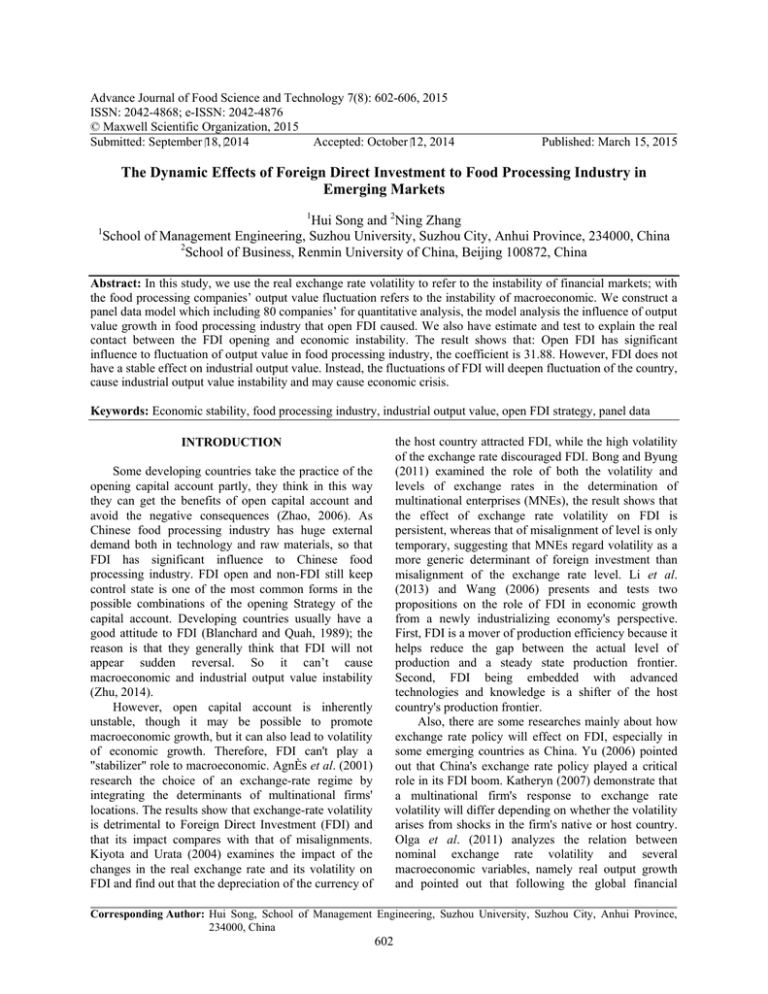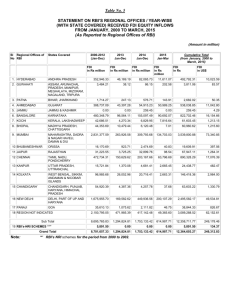Advance Journal of Food Science and Technology 7(8): 602-606, 2015
advertisement

Advance Journal of Food Science and Technology 7(8): 602-606, 2015 ISSN: 2042-4868; e-ISSN: 2042-4876 © Maxwell Scientific Organization, 2015 Submitted: September 18, 2014 Accepted: October 12, 2014 Published: March 15, 2015 The Dynamic Effects of Foreign Direct Investment to Food Processing Industry in Emerging Markets 1 Hui Song and 2Ning Zhang School of Management Engineering, Suzhou University, Suzhou City, Anhui Province, 234000, China 2 School of Business, Renmin University of China, Beijing 100872, China 1 Abstract: In this study, we use the real exchange rate volatility to refer to the instability of financial markets; with the food processing companies’ output value fluctuation refers to the instability of macroeconomic. We construct a panel data model which including 80 companies’ for quantitative analysis, the model analysis the influence of output value growth in food processing industry that open FDI caused. We also have estimate and test to explain the real contact between the FDI opening and economic instability. The result shows that: Open FDI has significant influence to fluctuation of output value in food processing industry, the coefficient is 31.88. However, FDI does not have a stable effect on industrial output value. Instead, the fluctuations of FDI will deepen fluctuation of the country, cause industrial output value instability and may cause economic crisis. Keywords: Economic stability, food processing industry, industrial output value, open FDI strategy, panel data the host country attracted FDI, while the high volatility of the exchange rate discouraged FDI. Bong and Byung (2011) examined the role of both the volatility and levels of exchange rates in the determination of multinational enterprises (MNEs), the result shows that the effect of exchange rate volatility on FDI is persistent, whereas that of misalignment of level is only temporary, suggesting that MNEs regard volatility as a more generic determinant of foreign investment than misalignment of the exchange rate level. Li et al. (2013) and Wang (2006) presents and tests two propositions on the role of FDI in economic growth from a newly industrializing economy's perspective. First, FDI is a mover of production efficiency because it helps reduce the gap between the actual level of production and a steady state production frontier. Second, FDI being embedded with advanced technologies and knowledge is a shifter of the host country's production frontier. Also, there are some researches mainly about how exchange rate policy will effect on FDI, especially in some emerging countries as China. Yu (2006) pointed out that China's exchange rate policy played a critical role in its FDI boom. Katheryn (2007) demonstrate that a multinational firm's response to exchange rate volatility will differ depending on whether the volatility arises from shocks in the firm's native or host country. Olga et al. (2011) analyzes the relation between nominal exchange rate volatility and several macroeconomic variables, namely real output growth and pointed out that following the global financial INTRODUCTION Some developing countries take the practice of the opening capital account partly, they think in this way they can get the benefits of open capital account and avoid the negative consequences (Zhao, 2006). As Chinese food processing industry has huge external demand both in technology and raw materials, so that FDI has significant influence to Chinese food processing industry. FDI open and non-FDI still keep control state is one of the most common forms in the possible combinations of the opening Strategy of the capital account. Developing countries usually have a good attitude to FDI (Blanchard and Quah, 1989); the reason is that they generally think that FDI will not appear sudden reversal. So it can’t cause macroeconomic and industrial output value instability (Zhu, 2014). However, open capital account is inherently unstable, though it may be possible to promote macroeconomic growth, but it can also lead to volatility of economic growth. Therefore, FDI can't play a "stabilizer" role to macroeconomic. AgnÈs et al. (2001) research the choice of an exchange-rate regime by integrating the determinants of multinational firms' locations. The results show that exchange-rate volatility is detrimental to Foreign Direct Investment (FDI) and that its impact compares with that of misalignments. Kiyota and Urata (2004) examines the impact of the changes in the real exchange rate and its volatility on FDI and find out that the depreciation of the currency of Corresponding Author: Hui Song, School of Management Engineering, Suzhou University, Suzhou City, Anhui Province, 234000, China 602 Adv. J. Food Sci. Technol., 7(8): 602-606, 2015 Model design: This research mainly adopts the measurement of the cross-sectional data model, for cross-sectional data model, the important thing is their estimate results could pass the test of heteroscedasticity, test this study used including. crisis, “hard peg” countries may have experienced a more severe adjustment process than “floaters”. Chyau and Lind (2003) pointed out that the open door policy of China’s economic reform since the 1980s has attracted heavy Foreign Direct Investment (FDI) flows into China and use empirical analysis to find out the agglomeration effects generated by a Core-Periphery (CP) relation. This study extends and develops the dynamic open economic model based on the Aghion et al. (1998) to analysis the macroeconomic and financial instability problems which the open capital accounts FDI brings. In this study, we use the real exchange rate volatility to refer to the instability of financial markets; with the food processing industry’ output value fluctuation refers to the instability of macroeconomic. We construct a panel data model which including 30 food processing industry’ for quantitative analysis, the model analysis the influence of food processing industry’ output value growth that open FDI caused. We also have estimate and test to explain the real contact between the FDI opening and economic instability. HCSE test: This test gives heteroscedasticity consistent standard errors and the result of t-statistics (Kiyota and Urata, 2004; Ping, 1998). HACSE test: This test gives related standard deviation and t-statistic, the result can be used to analyze heteroscedasticity of Cross-sectional data and selfcorrelation of model residual (Robert and Julio, 1990). JHCSE test: The corresponding standard deviation of this test called Jackknife revised standard deviation (MacKinnon and White, 1985). This Statistics test is based on HCSE test. Establish the cross-section data model about FDI open influence the macroeconomic; the panel date includes 30 Chinese biopharmaceutical companies as samples: MATERIALS AND METHODS REER − VOLi = β 0 + β1 FDI i + β 2 χ i + ε i i i i i BioIOV − VOL = β 0 + β1 FDI + β 2 χ + ε The basic economic model: In dynamic and open model established by Agllion and Zhou (2001, 2004), the basic assumption is one country only one trade product; production factors are capital and a domestic specific endowment element. Definite P is the price of the specific element of the endowment; P is the relative price of non-trade product and trade product. Based on the macro economic theory, P is the real exchange rate. The largest supply constraints for domestic endowment elements is Z, one country savings is (1-a) of the final wealth, the total amount of economic individuals in different types is “1”. In Leontief economies, formula of GDP Y is: y = Min( K a, z ) REER is real effective exchange rate; REER-VOLi is the fluctuation in the sample (2000-2010) REER of country, FIOV-VOLi Is the fluctuation of food processing companies’ industrial output value growth after eliminating time trend of sample period. FDIi is direct investment amount of GDP of country i; specific data is the average from 2000 to 2010. Xi Includes other explanatory variables as: IMEXGDP = SUM of Export and import divided by GDP GSGDP = Government consumption divided by GDP GDPcap = GDP formed by unit capital M2GDP = Broad money supply divided by GDP CPI = Consumer price index i-diff = Balance of interest rates (one-year period) (1) In this formula: 1/a>r r K z = International interest rates = The current capital = Domestic endowment elements The original data are from international financial statistics IFS database of the International Monetary Fund (IMF). In addition, the interpretation of the model also include virtual variable DEX refer to exchange rate system: Because there has credit constraints in developing countries, the country which initial wealth accumulation is W B most can lending µW B , credit multiplier µ>0. Define L as borrowing amount, so one country can invest for I = W B + L. If there has credit constraints I = (1 + µ) W B , K = I-pz, the maximization of Y demands z = K/α, we can get: I − pz = az (3) 0, use the floating exchange rate system (4) DEX = 1, use the fixed exchange rate system Data collection and analysis: In order to analyze how the money supply effect on the food price, we use STATA 12.0 software and make a statistical analysis of (2) 603 Adv. J. Food Sci. Technol., 7(8): 602-606, 2015 FDI, GDP, food processing companies’ industrial output value and the real effective exchange rate from the year of 2000 to 2013. All data was collected from China statistical yearbook 2013, Chinese price information network and Caixin database. In order to eliminate the effect of heteroscedasticity, we performed logarithmic processing of data and named them as LnM2, LnGDP and LnFP. Data stable is the premise of establishing VAR model, an Augmented Dickey-Fuller test (ADF) is a test for a unit root in a time series sample. We use ADF unit root test to inspect all the data, the result as is shown in Table 1. Through the test results we can get that all data are stationary at 5% critical value. Regression analysis: According to data sample, we analyze whether the open FDI influence the fluctuation of real exchange rate, the result such as Table 2. From Table 2, we find that open FDI of capital account does not produce significant influence to real effective exchange rate, this result is consistent with the model. In addition, DEX in 10% significant level will influence exchange rate fluctuations. In general, effective exchange rate fluctuate less in the fixed exchange rate system. According to the data, we analyze whether FDI influence fluctuation of food processing companies’ growth, the result shows in Table 3. Based on the result of coefficient and residue test, model can through the test of heteroscedasticity in 95% confidence level. Open FDI has significant influence to fluctuation of food RESULTS AND DISCUSSION ADF unit root test: The unit root test was first put forward by David Dickey and Wayne Fuller, so it is also called DF test. DF test is a basic method in stationary test, if we have a model as: Yt = ρYt −1 + µ t (5) DF test is the significance test to the coefficient. If ρ<1, when T→∞, ρ T →0, that means the impulse will be reduced when the time is increased. However, if ρ≥1, the impulse will not be reduced with the time, so that this time-series data is not stable. The basic DF test model can be written as: Yt = β1 + β 2 t + (1 + δ )Yt −1 + µ t (6) Table 1: Augmented Dickey-Fuller test (ADF) Test 5% critical Variable statistic value FDI -3.469 -3.000 IMEXGDP -4.571 -3.000 GDPCap -3.957 -3.000 CPI -4.099 -3.000 DEX -3.467 -3.000 GSGDP -3.270 -3.000 If we add the lagged variable of ∆Υt in formula 10, then it will be called the augmented Dickey-Fuller test, so that ADF test model can be written as: m ∆Yt = β1 + β 2t + δYt −1 + α i ∑ ∆Yt −i + ε t (7) i =1 10% critical value -2.630 -2.630 -2.630 -2.630 -2.630 -2.630 Result Stable Stable Stable Stable Stable Stable Table 2: Effect of FDI on real exchange rate Coefficient S.E. HACES (Std.) HCES JHCES FDI -0.0237 0.0678 0.0304 0.0248 0.0654 IMEXGDP 0.0314 0.0189 0.0263 0.0254 0.0256 GDPCap 1.1430 0.3145 0.4245 0.3421 0.3529 CPI 0.5760 0.1534 0.2365 0.1875 0.2134 DEX -2.6370 1.6342 1.4258 1.6345 1.8942 Coefficient t-statistic HACES (t-statistic) HCES JHCES FDI -0.0234 -0.3208 -0.7512 -0.8364 -0.3402 IMEXGDP 0.0356 1.6871 1.3422 1.4823 1.3045 GDPCap 1.2434 3.4563 2.6345 3.5398 3.1245 CPI 0.6583 3.4678 2.5435 3.1032 2.5489 DEX -2.6430 -1.8034 -2.0493 -1.6726 -1.5101 Dependent variable: REER-VOL; S.E. of regression: 4.087; Sum squared resid.: 501.2; Durbin-Watson stat: 2.34; Included observation: 30; Numbers of parameter: 5; S.E.: Standard deviation Table 3: Effect of FDI on food processing industry growth Coefficient S.E. HACES (Std.) HCES JHCES FDI 31.880 13.642 3.4212 3.2456 24.732 IMEXGDP -181.450 108.340 74.2430 75.3140 78.342 GSGDP -1145.100 660.340 680.2300 702.9300 728.340 Constant 48712 14265 18239 18302 18423 Coefficient t-statistic HACES (t-statistic) HCES JHCES FDI 31.478 2.3493 9.3450 10.4310 1.1913 IMEXGDP -182.340 -1.2359 -2.4642 -2.3704 -2.3283 GSGDP -1234.100 -1.2359 -1.7424 -1.7392 -1.6934 Constant 49230 3.4256 2.5739 2.6368 2.6453 S.E.: Standard deviation; Dependent variable: FIOV-VOL; Overall model test: F (3, 53) = 4.711 [0.005]**; Included observation: 30; Numbers of parameter: 4 604 Adv. J. Food Sci. Technol., 7(8): 602-606, 2015 Table 4: Granger causality test Equation Excluded LnFPI LnFDI LnFDI LnFPI LnFPI LnREER LnREER LnFPI chi2 15.3170 3.5486 12.8530 3.9461 df 2 2 2 2 processing industry will also be influenced by the real effective exchange rate of RMB. Prob.>chi2 0.000 0.362 0.000 0.126 CONCLUSION In this study, the result shows that: FDI has the important influence to the food processing industry growth; at the same time, open FDI may lead instable consequences to food processing industry. In empirical section, we use model show that FDI will not cause real exchange rate fluctuations in the long-term, mixed items (WB+FDI) will keep stable, but WB may fluctuate with the volatility of the FDI, so food processing industry growth will be unstable. In addition, government intervention cannot eliminate the macro economic instability phenomena. Because FDI decided by exogenous factors, domestic policy makers cannot calculate the right FDI value, so the policy makers in fact neither know, also can't make all kinds of capital flow achieve the right level and thus they can't avoid macroeconomic instability. Practice proves that macro-control is not easy, successful macroeconomic regulation and control only make domestic economic parameter fluctuated following intention of foreign capital investment. But if the policy makers fail to control effectively, the country will face economic bubble and inflation with the rapid increase of the foreign capital; if foreign sudden fall, bubble will burst and deflation appeared. Therefore, open FDI is not a "stabilizer". processing companies’ growth, coefficient is 31.88. However, FDI does not have a stable effect on food processing industry. Instead, the fluctuations of FDI will deepen fluctuation of the country, cause food processing industry instability and cause economic crisis. Granger causality test: Granger test is put forward by Granger and Sims, The Granger causality test is a statistical hypothesis test for determining whether one time series is useful in forecasting another, A time series X is said to Granger-cause Y if it can be shown, usually through a series of t-tests and F-tests on lagged values of X (and with lagged values of Y also included), that those X values provide statistically significant information about future values of Y, we assume a VAR model as: k k i =1 i =1 y t = ∑ a i y t −i + ∑ β i xt −i + u t (8) So the null hypothesis will be: H 0 : β1 = β 2 = ⋅ ⋅ ⋅ = β k = 0 (9) ACKNOWLEDGMENT The work of this study is supported by National Social Science Youth Fund Project “Research on Rural Tourism Sustainable Development Strategy based on Urban-rural Integration” (No: 13CJY106). If all the parameter estimates of x are not significant, then the null hypothesis will not be rejected. In other words, if there is any parameter estimate of x significant, that means x is the granger reason to y. This test can be shown by F statistics: F= (SSEr − SSEu ) k SSEu (T − kN ) REFERENCES (10) Aghion, P., P. Bachetta and A. Banerjee, 1998. Financial Liberalization and Volatility in Emerging Market Economies. Working Papers, Study Center Gersemee, Swiss National Bank, 8: 3-20. Agllion, N. and L. Zhou, 2001. Time series model for foreign direct investment spillover. Int. J. Appl. Math. Stat., 49: 535-543. Agllion, N. and L. Zhou, 2004. Efficiency of finance development on improving technological innovation: Interactions with carbon markets. J. Appl. Sci., 24: 5700-5707. AgnÈs, B.Q., F. Lionel and L. Amina, 2001. Exchangerate strategies in the competition for attracting foreign direct investment. J. Jpn. Int. Econ., 15: 178-198. Blanchard, O.J. and D. Quah, 1989. The dynamic effects of aggregate demand and supply disturbances. Am. Econ. Rev., 4: 655-673. In this formula, SSEr represents the residual sum of squares when null hypotheses was passed and SSEu represents the residual sum of squares when null hypotheses was not passed, k represents the lag length, N represents the number of variables. In order to examine causal relationship between the LnREER, LnFDI and LnFPI, we performed the Granger causality test for the model and the results are shown in Table 4. According to the test results, the real effective exchange rate of RMB is Grainger reason to food processing industry growth and foreign direct investment is also the Grainger reason to the food processing industry growth. In fact, the rising of exchange rate is also the reason for the decline of manufacturing industry, so it can prove that the food 605 Adv. J. Food Sci. Technol., 7(8): 602-606, 2015 Olga, A., F. Davide, M. Reiner and Z. Aleksandra, 2011. The effect of nominal exchange rate volatility on real macroeconomic performance in the CEE countries. Econ. Syst., 35: 261-277. Ping, H., 1998. On primary commodity prices: The impact of macroeconomic/monetary shocks. J. Policy Model., 20: 767-790. Robert, S.P. and J.R. Julio, 1990. The excess comovement of commodity prices. Econ. J., 403: 1173-1189. Wang, S., 2006. Research on co integration and constraint of China's monetary income rate. J. Quant. Tech. Econ., 4: 190-192. Yu, Q., 2006. China's FDI and non-FDI economies and the sustainability of future high Chinese growth. China Econ. Rev., 17: 198-209. Zhao, L., 2006. Experience analysis of the core inflation rate and the output gap in China. China Econ. Quart., 3: 79-81. Zhu, Y.Y., 2014. Research on China rural land circulation legal system based on land and energy. Energy Educ. Sci. Tech. Part A. Energ. Sci. Res., 32(1): 51-55. Bong, S.L. and S.M. Byung, 2011. Exchange rates and FDI strategies of multinational enterprises. PacBasin Financ. J., 19: 586-603. Chyau, T. and F. Lind, 2003. FDI facilitated by agglomeration economies: evidence from manufacturing and services joint ventures in China. J. Asian Econ., 13: 749-765. Katheryn, N.R., 2007. The endogeneity of the exchange rate as a determinant of FDI: A model of entry and multinational firms. J. Int. Econ., 71: 344-372. Kiyota, K. and S. Urata, 2004. Exchange rate, exchange rate volatility and foreign direct investment. World Econ., 27: 1501-1536. Li, W., H. Xie and Y. Wang, 2013. Research on the dynamic relationship of economy, energy consumption and urbanization in China based on VECM. Energy Educ. Sci. Tech. Part A. Energ. Sci. Res., 31(4): 2039-2046. MacKinnon, J.G. and H. White, 1985. Some heteroskedasticity-consistent covariance matrix estimators with improved finite sample properties. J. Econometrics, 29: 305-325. 606






